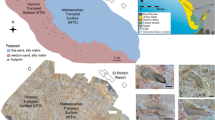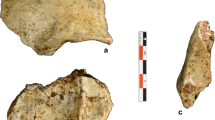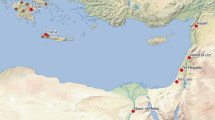Abstract
THE oldest secure date for human occupation in Greater Australia is 40kyr from eastern Papua New Guinea1, whereas slightly younger dates have been reported from southern Australia2. We now report thermoluminescence (TL) dates that suggest the arrival of people between 50 and 60 kyr in northern Australia. TL dates were obtained from sandy footslope deposits at two former occupation sites that yielded a range of stone artefacts in their primary depositional setting. Artefacts terminated mid-way down one profile, which had a basal age of about 100 kyr. Confidence in the TL dates is given by their close correspondence with radiocarbon dates obtained from the upper occupation levels. These TL dates are not only the oldest yet proposed for Aboriginal occupation but also may mark the time of initial human arrival on the Australian continent.
This is a preview of subscription content, access via your institution
Access options
Subscribe to this journal
Receive 51 print issues and online access
$199.00 per year
only $3.90 per issue
Buy this article
- Purchase on Springer Link
- Instant access to full article PDF
Prices may be subject to local taxes which are calculated during checkout
Similar content being viewed by others
References
Groube, L., Chappell, J., Muke, J. & Price, D. Nature 324, 453–455 (1986).
Allen, J. Search 20, 149–154 (1989).
Kamminga, J. & Allen, H. Alligator Rivers Environmental Fact-Finding Study: Report of the Archaeological Survey (Department of the Northern Territory, Darwin, 1973).
Schrire, C. The Alligator Rivers: Prehistory and Ecology in Western Arnhem Land (Department of Prehistory, Australian National University, Canberra, 1982).
Wintle, A. G. & Huntley, D. J. Quat. Sci. Rev. 1, 31–53 (1982).
Aitken, M. J. Thermoluminescence Dating (Academic, London, 1985).
Berger, G. W. Geol. Soc. Amer. Special Paper 227, 13–50 (1988).
Readhead, M. L. Ph.D thesis, Australian National University (1984).
Singhvi, A. K., Sharma, Y. P. & Agrawal, D. P. Nature 295, 313–315 (1982).
Huntley, D. J. Phys. Chem. Miner. 12, 122–127 (1985).
Galloway, R. W. in Lands of the Alligator Rivers Area, Northern Territory 52–70 (CSIRO Land Research Series, No. 38, 1976).
Murray, A. S., Marten, R., Johnston, A. & Martin, P. J. Radioanalyt. Nucl. Chem. Art. 115, 263–288 (1987).
Murray, A. S. D.Phil thesis, Univ. Oxford (1981).
Prescott, J. R. & Stephan, L. G. PACT 6, 17–25 (1982).
Prescott, J. R. & Hutton, J. T. Nucl. Tracks Radiat. Meas. 14, 223–227 (1988).
Wintle, A. G. Nature 245, 143–144 (1973).
Author information
Authors and Affiliations
Rights and permissions
About this article
Cite this article
Roberts, R., Jones, R. & Smith, M. Thermoluminescence dating of a 50,000-year-old human occupation site in northern Australia. Nature 345, 153–156 (1990). https://doi.org/10.1038/345153a0
Received:
Accepted:
Issue Date:
DOI: https://doi.org/10.1038/345153a0
This article is cited by
-
More than a decade of genetic research on the Denisovans
Nature Reviews Genetics (2024)
-
65,000-years of continuous grinding stone use at Madjedbebe, Northern Australia
Scientific Reports (2022)
-
Local and Indigenous management of climate change risks to archaeological sites
Mitigation and Adaptation Strategies for Global Change (2018)
-
Aboriginal mitogenomes reveal 50,000 years of regionalism in Australia
Nature (2017)
-
Early signs of human presence in Australia
Nature (2017)
Comments
By submitting a comment you agree to abide by our Terms and Community Guidelines. If you find something abusive or that does not comply with our terms or guidelines please flag it as inappropriate.



